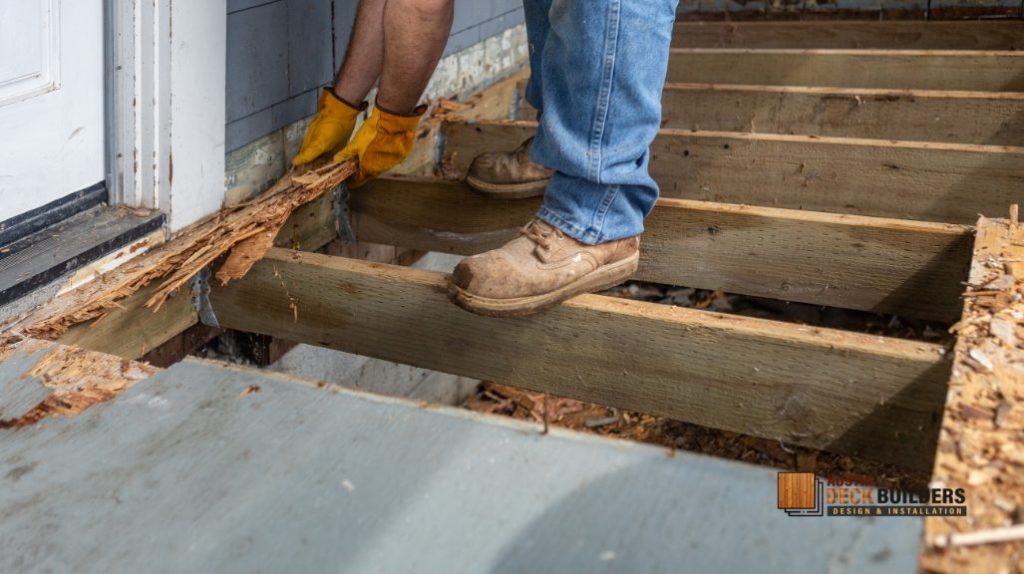TL;DR
Your deck may be hiding dangerous structural problems. Signs such as wood rot, sinking footings, and loose railings often indicate deeper safety hazards. This guide helps you identify, evaluate, and address structural issues before they become more costly or put your family at risk.
Why Structural Integrity Matters
Your deck isn’t just an aesthetic extension of your home—it’s a load-bearing structure. In Austin’s fluctuating climate, high heat, humidity, and expansive soil movement all wear down deck components over time. That’s why understanding the early signs of structural issues is vital for your family’s safety and your home’s resale value.
1. Visible Rot or Mold on Support Posts

Rot and mold aren’t just cosmetic concerns—they signal compromised structural strength. Wood rot weakens support posts and beams, often beginning in places that don’t get enough airflow or drainage.
What to look for:
- Soft or spongy wood
- Black or green patches
- Flaking or crumbling surfaces
If caught early, you may only need to repair the affected post. Otherwise, replacement may be required.
2. Wobbling or Loose Railings
Railings are key to deck safety, especially if your deck is elevated. If they wobble or sway under pressure, they could be improperly fastened—or worse, the posts themselves could be deteriorating.
Fix:
Check the anchoring of your rail posts to the deck frame. If they’re nailed instead of bolted, reinforcement is essential. Review this guide on railing repair for actionable steps.
Explore the most common culprits behind deck deterioration in our blog: What Causes Deck Damage? Weather, Wear, and Other Factors.
3. Sinking or Uneven Footings
Footings that appear sunken, tilted, or unstable can cause the entire frame to shift out of alignment. This is especially common in Austin’s clay-heavy soil, which expands and contracts with the seasons.
Watch for:
- Uneven stairs or a slanted deck surface
- Gaps between the ground and posts
- Soil erosion around the base
It’s often a sign that your deck needs structural releveling or new concrete footings.
4. Ledger Board Pulling Away
The ledger board connects your deck to your home. If it’s detaching or shows signs of rusted lag bolts and water intrusion, this is a significant safety red flag.
Warning signs:
- Visible gaps between the house and deck
- Sagging or bouncy deck frame
- Leaking into your home’s foundation wall
Loose ledgers can lead to deck collapse—don’t delay inspection.
5. Cracked or Split Joists and Beams

Joists and beams bear most of the weight. Cracks, especially along the grain or near joints, can mean they’re no longer sound.
Check for:
- Long vertical cracks
- Joists pulling away from hangers
- Sagging or creaking areas
It may be time to consult Austin Deck Builders for a comprehensive inspection.
6. Rusted or Corroded Fasteners and Connectors
Fasteners like joist hangers, lag bolts, and screws are small parts with a big job. When they rust or fail, the structure starts to unravel.
Fixes:
- Replace with galvanized or stainless steel hardware
- Apply anti-corrosion tape or sealant
- Ensure all brackets are securely nailed or bolted
7. Excessive Bounce or Movement
A deck that feels like a trampoline likely has undersized joists or poor bracing.
Test it:
- Stand at the center and rock gently on your heels
- Note how much give or vibration you feel
- Check for diagonal bracing underneath
Too much bounce weakens joints and fasteners over time.
8. Deck Age and Material Breakdown Over Time
Even the best-built decks have a lifespan. Cedar, pine, and pressure-treated wood can last 10–15 years. Composite decks can go 25+ years, but even they degrade with UV exposure and improper maintenance.
Ask yourself:
- Was this deck installed over a decade ago?
- Has it been resealed or maintained regularly?
- Are materials showing widespread wear?
It may be time to consult Austin Deck Builders for a comprehensive inspection.
How to Perform a Basic Structural Check

Use this checklist to spot early warning signs:
- Walk the perimeter and look for areas that are sloping or sinking.
- Tap posts and beams with a screwdriver—soft = rot.
- Check railing stability.
- Look for rust around fasteners.
- Stand in the middle and test for bounce.
- Inspect underneath for mold, split joists, or water damage.
When to Repair vs. When to Replace
Some signs are repairable, like replacing a cracked board or tightening loose railings. But if foundational posts, beams, or ledger boards are compromised, replacement may be the safer route.
For a complete breakdown, read our guide:
Deck Repair vs Replacement in Austin: How to Make the Right Choice
This guide covers cost factors, safety risks, and how to future-proof your investment.
The Role of Material Selection in Structural Integrity
Choosing the right material upfront significantly reduces structural risks. Cedar is beautiful and naturally resistant to insects, but it softens over time. Pressure-treated wood is durable but vulnerable to moisture if not sealed. Composite materials offer superior weather resistance but may still warp if poorly installed.
Discuss options with a decking specialist to match material type with Austin’s unique weather and soil conditions.
Weather and Climate Factors That Accelerate Damage
In Austin, decks face extreme sunlight, sudden temperature shifts, humidity spikes, and flash flooding—all of which can quickly deteriorate decking materials. Heat dries out wood, while moisture causes it to expand. This cycle shortens the lifespan of most decks.
Installing under-deck drainage systems, using UV-resistant sealants, and performing seasonal maintenance are crucial to mitigating the effects of the local climate.

